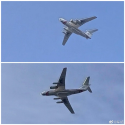This JH-XX could be used for long distance maritime strike. Having a large supersonic bomber type aircraft would enable the use of higher speed anti shipping missiles. The faster the carrier platform is, the less energy the missile will have to expend to reach its target velocity.
Another possibility is direct strikes against second island chain targets without refueling, and third island chain targets with refueling.
One possible requirement is a larger weapons bay capable of launching longer range precision weapons.
However now that the J-20S has come out, and the WS-15 is available, I wonder if there is any added benefit in designing a specific twin engine bomber airframe. The J-16 could easily be replaced with some J-20S variant.
This is already addressed above, including the maritime strike role.
Everyone agrees that JH-XX could fill a role that other platforms do not, but the question is whether it is worthwhile enough to actually develop and buy it.
I don't mean to beat a dead horse, but right now there's basically nothing new that can be said about a notional JH-XX, as it ultimately just comes down to whether the opportunity cost for it is worthwhile in context of the other aerospace projects the PLA is pursuing.
IMO unless we have any credible rumours suggesting JH-XX is actually under development, there really isn't too much more than can be said about JH-XX which hasn't already been surgically peeled apart and examined over the last ten years.

